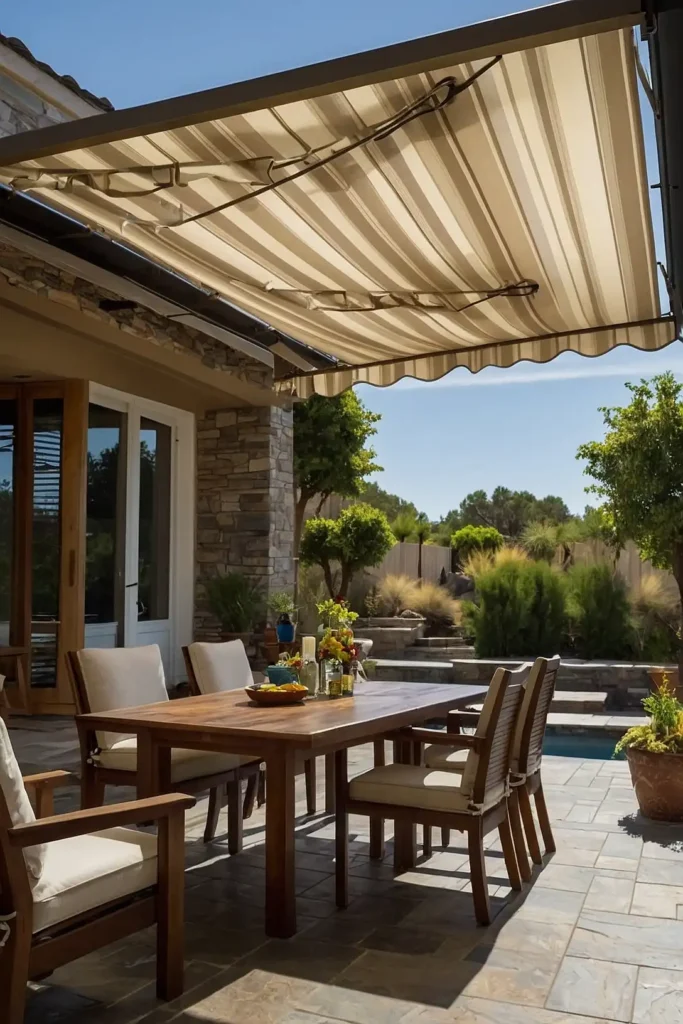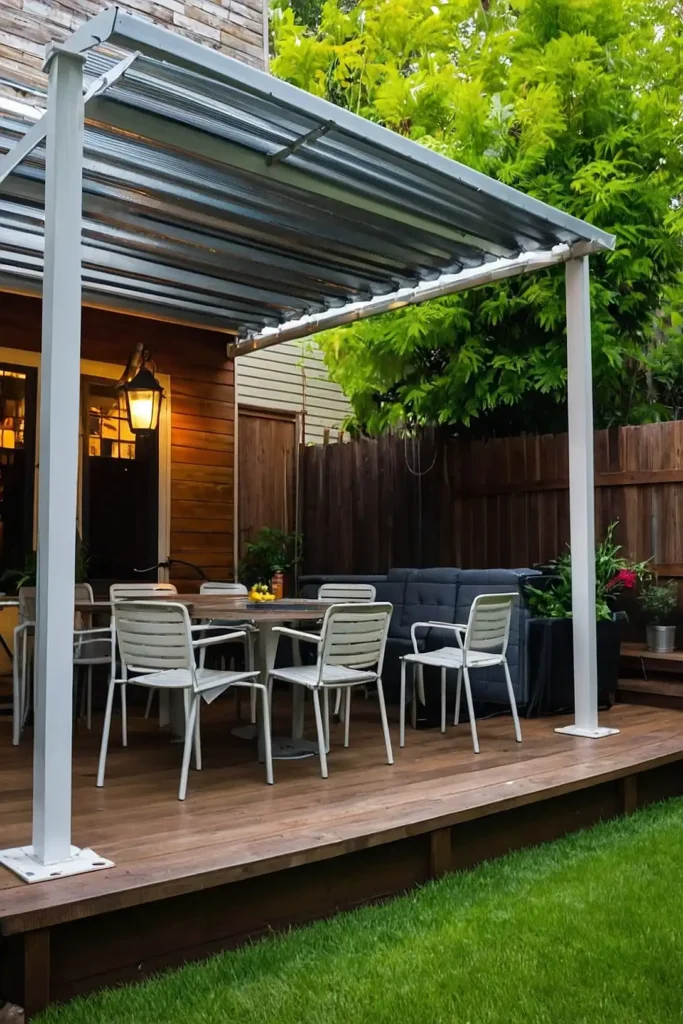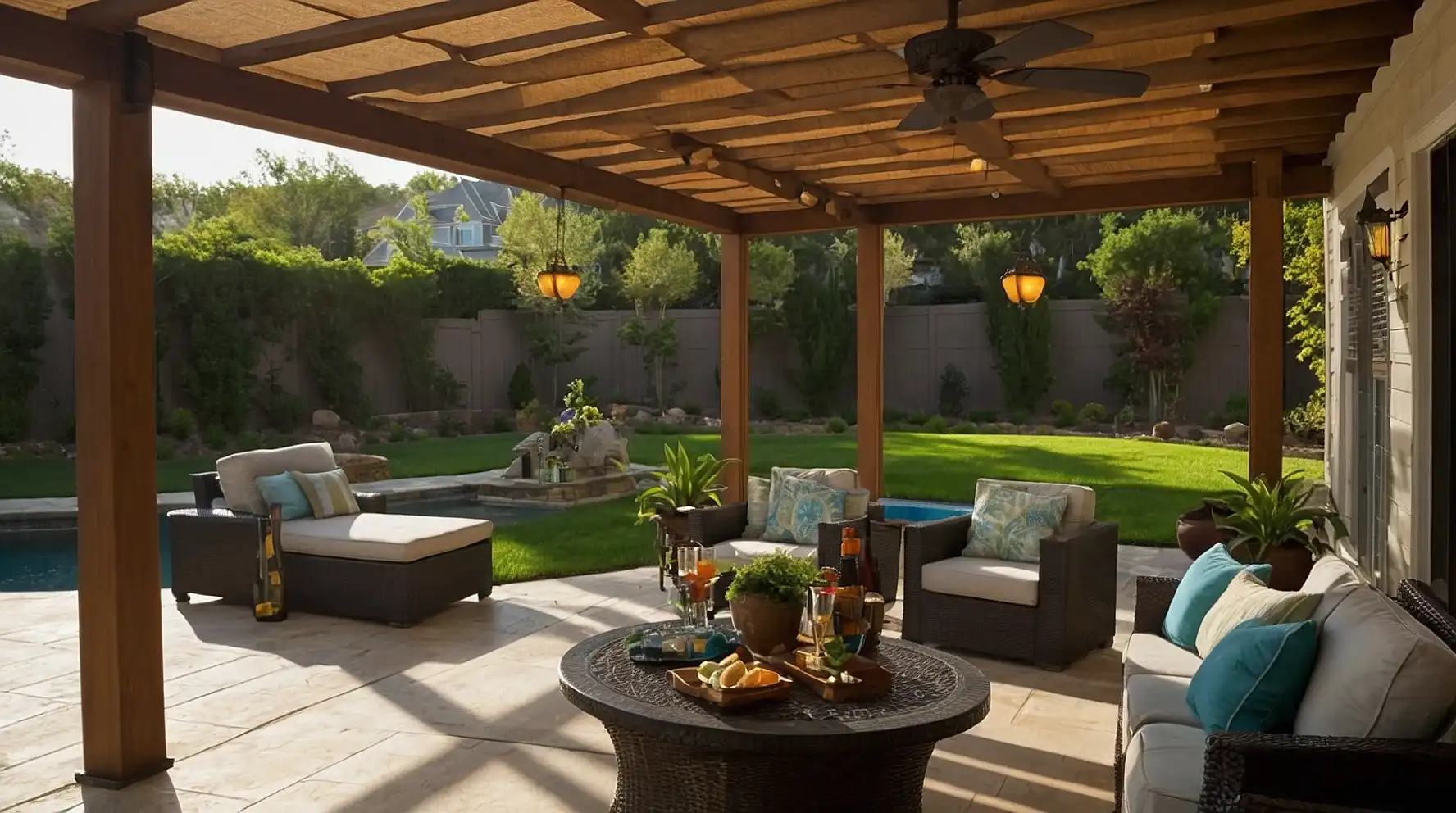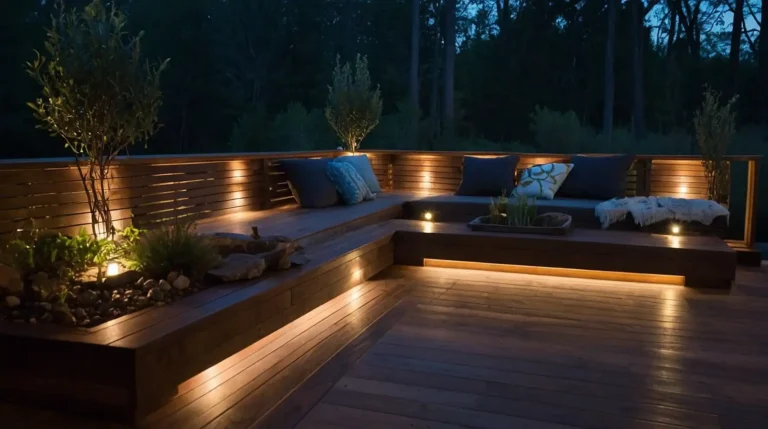27 Creative Patio Shade Ideas to Transform Your Outdoor Space
A comfortable patio extends your living space outdoors, but without proper shade, even the most beautiful outdoor area becomes unusable during hot, sunny days.
The right shade solution combines practicality with style, enhancing your patio’s aesthetics while making it more functional.
Today’s shade options go far beyond basic umbrellas, offering innovative solutions for spaces of all sizes and styles.
From budget-friendly DIY projects to architectural statement pieces, you’ll find options that match your needs and design preferences.
Ready to make your patio comfortable in any weather?
Explore these 27 creative shade ideas that balance sun protection with style to transform your outdoor living experience.
1: Retractable Awning

Install a retractable awning to gain flexible control over your patio shade throughout the day.
This adjustable solution lets you extend full coverage during intense sun or retract completely to enjoy stargazing on clear evenings.
Modern awnings come in motorized options with weather sensors that automatically retract during high winds to prevent damage.
The wide range of fabric colors and patterns helps you complement your home’s exterior design.
For maximum versatility, choose a high-quality marine-grade fabric with UV protection that resists fading and water damage for years of reliable service.
2: Sail Shade Installation

Mount triangular or rectangular shade sails to create architectural interest while blocking harmful rays.
These tensioned fabric installations add a contemporary, resort-like feel to any outdoor space.
Install at varied heights and angles for improved airflow and dynamic visual appeal.
The overlapping design creates interesting shadow patterns that change throughout the day as the sun moves.
Choose high-density polyethylene fabrics engineered specifically for sun protection, offering up to 98% UV blockage while allowing cooling breezes to flow through.
3: Living Pergola

Transform a standard pergola into a living shade structure by training vines to grow across the top.
This natural approach combines architectural elements with plants for evolving beauty throughout the seasons.
Choose deciduous vines like wisteria or grape that provide thick summer shade but allow winter sunlight through after leaves fall.
The changing seasonal coverage naturally adjusts to your comfort needs.
Supplement with string lights woven among the greenery to create magical evening ambiance when your natural canopy becomes a twinkling ceiling after sunset.
4: Bamboo Shade Roll

Install natural bamboo roll-up shades along the sides or top of your pergola or porch for an eco-friendly solution with tropical appeal.
These versatile coverings filter light while adding organic texture to your space.
Choose mounted options with pulley systems for easy adjustment as the sun moves throughout the day.
The filtered light creates beautiful dappled patterns on your patio floor.
For added durability, select bamboo rolls treated with weather-resistant coatings that prevent mold and extend their lifespan in outdoor conditions.
5: Outdoor Curtains

Hang weather-resistant curtains around your patio perimeter to create flexible, elegant shade that enhances privacy.
This soft architectural element adds resort-style luxury to your backyard retreat.
Select fade-resistant, quick-drying fabrics designed specifically for outdoor use.
Heavier options provide more substantial sun blocking, while sheerer versions filter light while maintaining airflow.
Install curtain panels on sliding rings for easy opening and closing, allowing you to adjust your shade coverage as the sun position changes throughout the day.
6: Pergola with Retractable Canopy

Combine the architectural structure of a pergola with the flexibility of a retractable canopy for the ultimate shade solution.
This hybrid approach offers both strong visual appeal and practical functionality.
Install a waterproof canopy system that glides along tracks mounted to your pergola beams, providing protection from both sun and unexpected rain showers.
Remote-controlled options add convenient operation.
The permanent framework offers opportunities for hanging plants, lights, and heaters, creating a truly versatile outdoor room for year-round enjoyment.
7: Offset Cantilever Umbrella

Replace standard center-pole umbrellas with an offset cantilever model that positions the support structure to the side.
This design innovation keeps the space beneath completely open for furniture arrangement.
Choose models with 360-degree rotation and adjustable tilt functions to track the sun throughout the day.
The larger canopy size typically provides coverage for an entire conversation or dining set.
Look for UV-resistant fabrics on powder-coated, rust-resistant frames for maximum durability in changing weather conditions.
8: Louvered Roof System

Install a louvered roof system with adjustable slats that rotate to control sunlight, ventilation, and rain protection.
This high-end solution offers unprecedented control over your outdoor environment.
Adjust the angles precisely to block direct sun while allowing cooling breezes to flow through.
Fully closed, the system creates a waterproof ceiling during light rain showers.
Automated systems can connect to weather stations, automatically adjusting to changing conditions even when you’re away from home.
9: Tiered Shade Umbrella

Select a two-tier market umbrella that allows heat to escape through the vented top while maximizing shade coverage below.
This smart design creates better airflow than traditional umbrellas.
The double-canopy construction prevents the heat-trapping effect common with standard umbrellas, keeping your seating area noticeably cooler on hot days.
The unique profile also adds visual interest to your patio.
Choose models with built-in solar lights along the ribs for functional illumination that extends your outdoor enjoyment into evening hours.
10: Climbing Plant Wall

Build a vertical trellis structure along sun-exposed patio edges to support shade-producing climbing plants.
This living wall creates cooling shade while adding lush greenery to your outdoor space.
Select fast-growing climbers like morning glory for quick coverage or sturdier perennials like clematis for long-term solutions.
The dense foliage filters sunlight while absorbing heat.
Position the plant wall strategically to block western afternoon sun when temperatures typically reach their daily peak for maximum cooling effect.
11: Shade Trees in Planters

Place strategic large containers with small shade trees to create natural, movable shade sources.
This flexible approach allows you to rearrange your shade pattern as needed throughout the seasons.
Choose dwarf varieties of normally large shade trees, or select naturally smaller species like Japanese maple that provide dappled light rather than dense shade.
The height creates beautiful dimension in your patio design.
Use substantial containers with hidden casters for easier repositioning, and install automatic irrigation systems to maintain healthy growth despite restricted root zones.
12: Portable Cabana

Add a free-standing cabana that creates an instant shade retreat without permanent installation.
This self-contained solution works perfectly for renters or those who like to reconfigure their outdoor spaces.
Select models with adjustable side panels that can be positioned to block morning or afternoon sun as it moves across the sky.
Many options include built-in seating or surfaces for convenience.
Look for lightweight yet sturdy designs that can be easily relocated but won’t blow over in moderate winds.
13: Bamboo Pergola

Construct a pergola using natural bamboo poles for an eco-friendly, tropical-inspired shade structure.
This sustainable material creates distinctive character with minimal environmental impact.
The natural variations in bamboo diameter and color create organic visual interest unlike standard lumber.
Choose thick-walled bamboo varieties specifically treated for outdoor structural applications.
Complete the structure with a simple canvas cover, natural reed mats, or climbing plants to create your desired level of sun filtration.
14: Modern Slatted Overhang

Extend your architectural style with a contemporary slatted wood or metal overhang.
This semi-permeable solution creates rhythmic shadow patterns while allowing for air circulation and partial views of the sky.
Adjust the spacing between slats to control the amount of light that filters through—closer for more shade, wider for a more open feel.
The linear pattern adds strong design interest to your outdoor space.
For a cohesive look, echo materials or finishes from your home’s exterior in your shade structure design.
15: Repurposed Sailcloth

Stretch weather-resistant sailcloth in an artistic configuration above your patio for nautical-inspired shade with sustainable appeal.
This creative approach gives new life to used sails from boats.
The heavy-duty material, designed to withstand marine conditions, provides excellent durability in any weather.
The unique shapes and potential weathering of authentic sails add character and conversation value.
Install with proper tension using marine-grade hardware to prevent sagging and ensure stability during windy conditions.
16: Pergola with Fabric Inserts

Weave outdoor fabric panels between the rafters of a traditional pergola to create customizable shade density.
This adaptable approach allows you to adjust coverage seasonally or as needs change.
Select weather-resistant fabrics in complementary colors to add visual interest to your overhead structure.
Different weave densities offer various levels of sun filtration and UV protection.
Install using a simple rod pocket system that allows for easy removal during winter months or for cleaning as needed.
17: Shade Screen Roll

Mount retractable solar screen rolls along the sides of your patio to block low-angle sun while maintaining your view.
These technical fabrics reduce heat and glare without creating a solid barrier.
Choose screen densities based on your priorities—denser weaves provide better sun protection, while more open weaves preserve better visibility.
Most options block 80-95% of UV rays while allowing airflow.
Motorized systems with wind sensors automatically retract during strong gusts, protecting your investment from weather damage.
18: Repurposed Door Awning

Create an eclectic shade solution by mounting a salvaged door horizontally above a small patio section.
This unexpected repurposing adds unique character while providing functional shade.
Remove the door’s glass panels and replace with metal screening, fabric inserts, or leave open for partial shade with interesting shadow patterns.
The solid frame provides perfect mounting points for hanging plants or lights.
Treat wood doors with marine-grade sealants for weather resistance, or embrace the weathered patina that develops naturally for rustic charm.
19: Pavilion with Gathered Ceiling

Install a permanent pavilion structure with a gathered fabric ceiling for resort-style luxury.
This dramatic shade solution creates a true outdoor room with architectural presence.
Choose weather-resistant fabrics in light colors that reflect heat while diffusing light beautifully throughout your space.
The gentle folds add softness to contrast with the structure’s straight lines.
Include proper drainage solutions within your design to prevent water pooling after rainfall, extending the life of both fabric and framework.
20: Pallet Wood Overhead

Transform reclaimed shipping pallets into an overhead shade screen with industrial-chic appeal.
This budget-friendly DIY project adds character while providing functional sun protection.
Disassemble pallets and reconstruct the wood into slatted panels sized for your specific space.
The varied coloration and weathering of pallet wood creates natural visual interest.
Treat the wood with non-toxic sealants to prevent further weathering, or allow it to silver naturally for a driftwood-inspired aesthetic.
21: Umbrella Canopy Cluster

Group multiple market umbrellas at varied heights to create an artistic canopy effect with excellent coverage.
This adaptable approach works well for oddly shaped patios or larger gathering areas.
Select umbrellas in complementary colors or patterns that coordinate with your outdoor décor.
The layered heights add dimensional interest while allowing you to direct shade precisely where needed.
Secure each umbrella in a substantial base, potentially anchored to your patio surface for additional stability during windy conditions.
22: Corrugated Metal Awning

Install a corrugated metal awning for industrial-modern shade with exceptional durability.
This low-maintenance solution adds architectural interest while providing complete sun and rain protection.
Choose from various metal finishes—galvanized for a raw industrial look, colored for design impact, or copper for evolving patina.
The ridged surface creates interesting light patterns during sunrise and sunset.
Include proper insulation between your roofing material and support structure to prevent excessive heat transfer and noise during rainfall.
23: Canvas Tarp Shade

Stretch heavy-duty canvas tarps across your patio for a rugged, nautical-inspired shade solution.
This practical approach offers exceptional durability with casual, relaxed style.
Select marine-grade canvas with reinforced grommets for secure attachment and longevity.
The substantial material provides excellent sun protection while withstanding heavy rain and wind.
Install with proper tension lines and sturdy anchoring points, potentially creating dramatic angles for visual interest and water runoff during unexpected showers.
24: Woven Branch Canopy

Create a rustic shade screen using collected branches woven between parallel support beams.
This nature-inspired approach adds organic texture while providing dappled light filtration.
Gather straight branches of similar diameter from pruning projects or woodland areas.
Weave them perpendicular to your support structure, varying density to control light penetration.
Allow climbing plants to intertwine with your branch framework for evolving coverage that increases over time as vegetation fills in.
25: Converted Window Awning

Repurpose vintage windows or shutters into a hinged awning system with adjustable positioning.
This character-rich solution combines architectural salvage with practical functionality.
Remove glass panels and replace with weather-resistant screening or leave the framework open for partial shade.
The hinged installation allows you to adjust angle and coverage as needed.
Enhance with hanging plants, solar lanterns, or other decorative elements suspended from the framework to personalize your unique shade creation.
26: Shade-Optimized Landscaping

Strategically plant fast-growing shrubs and ornamental trees around your patio perimeter for natural shade that improves with time.
This living solution adds habitat value while cooling your space.
Select species with different heights, densities, and bloom times to create year-round interest beyond basic shade function.
Consider deciduous varieties that allow winter sunlight through when warmth is welcome.
Place larger species on the west and southwest sides where afternoon sun creates the most intense heat, creating shade when you need it most.
27: Movable Shade Wall

Build rolling panels with slatted wood, metal, or fabric inserts to create repositionable shade barriers.
This flexible solution allows you to adjust coverage as the sun moves throughout the day.
Mount your panels on locking casters for easy movement without sacrificing stability.
Multiple panels can be used independently or connected to create various configurations.
Design with multi-functionality in mind—perhaps incorporating herb planters, storage elements, or serving surfaces into your mobile shade solution.
Conclusion
Your perfect patio shade solution might combine several of these ideas to address different needs throughout the day and seasons.
By balancing aesthetics, functionality, and your climate’s specific challenges, you’ll create an outdoor space that’s truly livable year-round.







